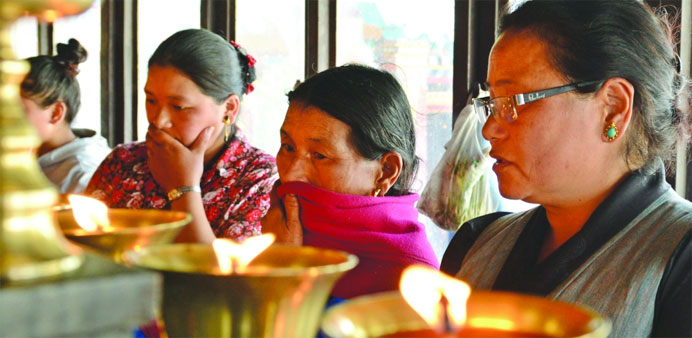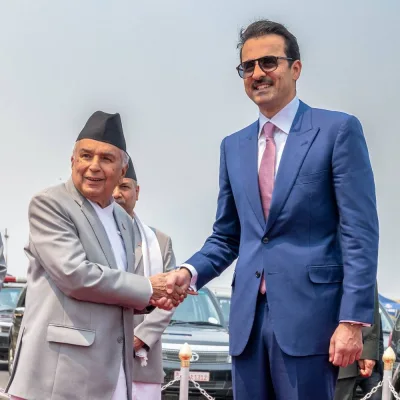The mother of Phurtemba Sherpa, second right, a victim of the Everest avalanche, and family members lighting oil lamps as they perform rituals at the Sherpa Monastery in Kathmandu yesterday.
AFP/Kathmandu
Nepal yesterday called off the search for local guides still missing after the deadliest accident on Mount Everest killed 13 colleagues, as climbers recalled the terrifying moments when the avalanche hit.
Rescuers have retrieved the bodies of 13 Sherpa guides and plucked another nine to safety since an ice and snow avalanche smashed into their expedition on Friday morning on the world’s highest peak.
Authorities have ruled out any hope of finding more survivors, and with bad weather hampering efforts, they have now decided to end the search for the three guides thought still buried.
“We have decided to stop the search for the missing. We have been unable to identify the location of bodies and at this stage it is difficult to find them in the snow,” tourism ministry official Dipendra Paudel said.
The guides were among a large party that left Everest’s base camp before dawn, carrying tents, food and ropes to prepare routes for international clients before the main climbing season starts later this month.
The avalanche hit them at an altitude of about 5,800m (19,000ft) in an area nicknamed the “popcorn field” due to ice boulders on the route, which leads into the treacherous Khumbu Icefall.
Dozens of guides were on the move when a huge block of ice broke off from a hanging glacier, before splitting into smaller chunks and barrelling down into the icefall, one of the most dangerous areas en route to the summit.
A guide on the mountain recalled how, moments after the avalanche struck, he and others spent hours digging through snow, pulling out bodies and rescuing injured colleagues.
“We heard a roar and when we looked up we saw a massive ball of snow coming towards us,” said Namgyal Sherpa, who was climbing the icefall when the accident happened.
“My first thought was we were all going to die,” the 38-year-old guide, who has summited the peak 11 times, said.
Moments after climbers heard the sound of crashing ice, they sprang into action, calling helicopter companies for help and trudging through snow to rescue stranded colleagues.
“We could see hands, legs and bags above the snow,” Sherpa said.
Joe Kluberton, Everest basecamp manager for Seattle-based Alpine Ascents International, said the local and foreign guides’ speedy response saved at least three lives.
“We got nine men off the mountain including three who were critically injured and needed immediate medical attention,” said Kluberton, whose team lost four Sherpas in the accident with another still missing.
Just 24 hours before the accident, Kluberton’s team had held a day-long prayer ceremony at base camp, asking priests to bless their climbing gear and putting up Buddhist flags, in line with local customs which consider Mount Everest to be sacred.
“We basically ask the mountain for permission to climb, we don’t cross base camp until we finish the prayer,” he said.
Two young members of the team, Nima Sherpa and Mingma Nuru Sherpa who lost their lives in the accident, had recently been promoted to climbing guides after spending four years working at base camp.
“They knew the risks, we are all familiar with the dangers of Everest, but it doesn’t make it any easier to lose your friends,” Kluberton said, his voice cracking with emotion.
The disaster underscores the huge risks borne by local guides who ascend the icy slopes, often in pitch-dark and usually weighed down by tents, ropes and food for their foreign clients, who pays tens of thousands of dollars to climb the mountain.
News of the accident sent shockwaves among the mountaineers, leaving some climbers and Sherpas considering whether to continue with their expeditions.
“At this point, we are in mourning, we are not ready to think of the future,” Kluberton said.
More than 300 people, most of them local guides, have died on Everest since the first ascent to the summit by Sir Edmund Hillary and Tenzing Norgay in 1953.
Decades of mountaineering have seen Everest becoming the final resting place for many climbers, whose bodies do not decompose in the extreme cold.
The previous worst accident on the 8,848m (29,029ft) peak was in 1996 when eight people were killed during a storm.
The government has issued permits to 734 people, including 400 guides, to climb Everest this summer season.
Survivor recalls horror of being ‘trapped’ by avalanche
AFP/Kathmandu
A young Nepalese guide who survived the deadliest mountaineering accident ever on Mount Everest recalled yesterday being “trapped” after the avalanche came crashing down the icy slopes, killing at least 12 of his companions.
The force of the avalanche fractured 22-year-old Dawa Tashi Sherpa’s ribs and broke his shoulder blades, leaving him buried in neck-deep snow — but he was fortunate to survive.
“I don’t know how I survived,” said 22-year-old Sherpa, who was airlifted to Kathmandu’s Grande International Hospital after being rescued.
“I am the luckiest man alive,” he said from his hospital bed, while his wife — five months pregnant with their first child — waited to see him.
Sherpa was among a large party of Sherpas carrying tents, food and ropes who headed out for an early morning expedition ahead of the main climbing season starting later this month.
Sherpa said he left the base camp of the 8,848m (29,029ft) peak at around 3am local time, armed with equipment to help fix ropes for commercial climbers.
As he scaled the mountain slopes in the dark, climbing ladders and walking on ice, dozens of guides kept him company, with several ahead of him and some others behind lugging up their gear.
The avalanche struck soon after daybreak at an altitude of about 5,800m (19,000ft) - in an area nicknamed the “popcorn field” due to boulders of ice that lie on the route leading into the treacherous Khumbu icefall.
“It came out of nowhere, this huge block of ice that fell from above, flying right at us,” Sherpa said.
“I wanted to run but there was no time, we were just trapped.”
Despite being hit by the full force of the avalanche, he said he managed to breathe and was conscious, though suffering from hypothermia.
He was eventually found by rescuers and airlifted to Kathmandu.
His doctor, orthopaedic surgeon, Chakra Raj Pandey, said he expected Sherpa to make a full recovery soon.
“He has suffered multiple wounds, but he is stable,” Pandey said, expressing optimism that his fractures would heal in around six weeks.



